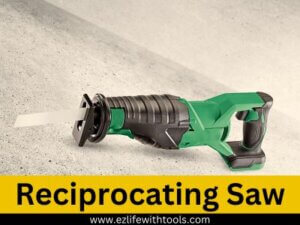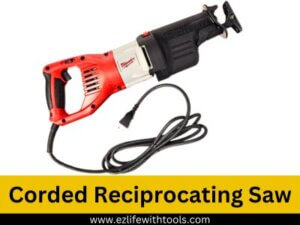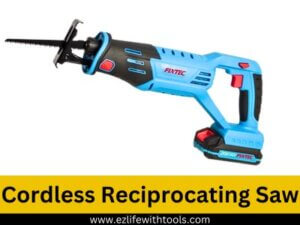Do I Need a Reciprocating Saw for Home Improvement?

When we plan to remodel any project at home, we require many tools to choose from, because each tool is designed for specific tasks.
Therefore, one essential question that we can face is, Do I need a reciprocating saw or not for home remodeling projects?
The simple answer is “YES”.
But we need to know what a reciprocating saw is, its benefits, and what we should consider when choosing it.
In this article, I will explain whether it is a valuable addition to your toolkit or Not.
So, keep reading.
What is Reciprocating Saw?
It is a handheld power tool used to cut many types of materials like wood, metal, plastic, and

masonry work. It has a typically straight blade that moves rapidly back and forth with the help of a powerful motor to make a quick and efficient cut for any material.
Basically, it comes in two varieties. One is corded, and the second one is cordless. We can’t only adjust the blade movement speed according to the material used in our project but also change the blade.
It is also known as “recipe saw” or “Sawzall.” It works for the tasks of demolition, remodeling, plumbing, electric work, and construction. Its multiple uses, access to tight spaces, and ability to adapt to different blade types have made it a popular choice for every DIY enthusiast and professional.
Why Do I Need a Reciprocating Saw?
If you are thinking that it is simple saw like others, you are wrong. It is not only a popular tool for DIY enthusiasts and professionals, but also a need. If we call it all-in-one, it would be an understatement.
Because this one tool do every aspect of work, whether you’re tackling home renovations, demolition projects, or woodworking tasks, you will be found it stand at first line of action.
The reciprocating saw’s rapid back-and-forth blade motion is its back bone which provide a precise and controlled cuts.
It works not only in open spaces but also have ability to navigate in tight spaces. You can customize its speed according to the nature of project material like wood, metal, and plastics.
The reciprocating saw’s portability and ease of use make it an essential addition to any toolkit, streamlining tasks and saving valuable time.
Reciprocating Saw Uses
It is a valuable tool for various home improvement projects. Here is the list of those major projects that are related to reciprocating saw uses in home improvement.
I will describe reciprocating saw use in each project in detail. Let’s get started.
- Demolition Work
- Pruning and Tree Trimming
- Metal Cutting
- Pipe and PVC Cutting
- DIY Home Renovations
1- Using Reciprocating Saw in Demolition Work
The primary work of a reciprocating saw is demolition work, which is a very powerful and suitable tool for this task. Whether you’re tearing down an old structure, removing walls or cabinets, or dismantling fixtures, there is no alternative to this tool.
Because It has the ability to cut through wood, drywall, nails, and even metal pipes.
The only thing to always remember is to use a specifically designed blade for heavy-duty cuttings and make sure to wear the necessary safety gear.
2- Using Reciprocating Saw in Pruning and Tree Trimming
If we fall in love with gardening and landscaping, we definitely require a cutting tool to trim the extra leaves and branches of the trees.
Reciprocating saw is the tool that can do it. Even pruning trees and cutting thick branches is not difficult in tight spaces.
But always wear safety goggles and gloves during the cutting process to ensure safety.
3- Using Reciprocating Saw in Metal Cutting
The reciprocating saw is a game-changer tool for metalwork. There is no limitation for metalwork. It can easily do steel, aluminum, and copper cutting for furniture and other projects.
It is an ideal choice for metal pipe cutting or removing old fastened metal fixtures. Metal cutting with smooth and clean finishing is possible only using the right blade.
So, always choose the right blade for reciprocating saw to enhance durability and efficiency.
4- Using Reciprocating Saw in Pipe and PVC Cutting
Plumbing is a necessary part of our life; without it, any project is incomplete. The main job in plumbing is to cut the plastic or PVC pipes.
So, the reciprocating saw is the best choice for multiple precise cuttings, ensuring that pipes fit together without any jagged edges.
Note: Be cautious because, in plumbing, we mostly face water, gas, or other substance pipes cutting. Always turn off the water or gas supply before cutting.
5- Using Reciprocating Saw in DIY Home Renovations
It is the only saw that every enthusiast should have in his toolbox because it has the ability to do multiple cutting work like removing old flooring, cutting drywall, pipes, metal, and masonry work.
It is also easy to use, which makes it an ideal choice for different home improvement tasks.
But, always start with a short blade length for better control; you will remain safe from any hidden wiring or plumbing line-cutting accident.
Note: All above projects are related to home improvement. Hence proves that, whether you’re a DIY enthusiast or a professional, the reciprocating saw is indispensable tool for tackling home improvement projects with precision and ease.
Advantages of Using a Reciprocating Saw
Reciprocating Saw has multiple advantages. Let’s explain it.
- Versatility: It is a versatile saw. We can cut multiple types of materials, making it a popular choice for every DIY enthusiast and professional.
- Speed: It has a controlled cutting speed feature. We can efficiently use it where we want to cut rapidly. It allows for rapid cutting.
- Precision: Due to controlled speed, it works very well in detailed work. Despite its power, a reciprocating saw works remarkably precisely when used correctly.
- Accessibility: It has a compact size and length. We can easily use it in tight and challenging spaces with perfection.
- Blade Changes: Reciprocating saw works for multiple materials, and we change the blade according to the materials. It has a built-in feature to change the blade quickly and adjust it.
- Minimal Dust and Debris: Unlike other cutting tools, reciprocating saws produce less dust and debris, making cleanup easier.
- Safety: When the reciprocating saw blade moves, minimal vibration is created. So, to reduce the accident risks, it comes with an anti-vibration mechanism and a safety guard for the blade.
- Cordless Options: Cordless reciprocating saws are portable devices that offer freedom of movement in outdoor tasks.
Considerations Before Buying a Reciprocating Saw
When you are going to add one more useful tool in your tool kit. It is necessary to analyze, before implementation. These are the basic consideration points to analyze.
- Budget
- Power Source
- Blade Selection
1- Budget
When we want to buy any kind of tool, first of all, it’s essential to maintain a balance between

your budget and the quality of the tool.
Simply, we should analyze what kind of projects we are going to do and how often we will use the reciprocating saw.
Professional contractors should choose a higher-priced saw, while DIY enthusiasts can choose a mid-range priced model of reciprocating saw.
It is not a hard and fast rule that middle-range saws are only for DIY enthusiasts. They can also buy a high-priced saw because investing in the best quality products can save money on repairs and replacements in the future.
2- Power Source
Reciprocating saws are available in two types according to the power source. One is Corded, and the second one is Cordless (powered by battery). Both have multiple advantages and limitations.
But before buying any kind of reciprocating saw, it is necessary to understand its factors and benefits.
Corded Reciprocating Saws: This type is ideal for heavy-duty projects like demolition work, cutting through dense materials, etc., because this type of project requires consistent and uninterrupted power sources. However, they are not portable due to the connection with the electrical outlet.
This type is ideal for heavy-duty projects like demolition work, cutting through dense materials, etc., because this type of project requires consistent and uninterrupted power sources. However, they are not portable due to the connection with the electrical outlet.
Cordless Reciprocating Saws: The name shows its characteristics. They offer great mobility and flexibility. However, due to the limited power source (battery), their performance is also limited and depends on the battery life.
the limited power source (battery), their performance is also limited and depends on the battery life.
But we can work with cordless reciprocating saws in outdoor locations where access to electricity is unavailable.
Note: Before buying, it’s your responsibility to evaluate which kind of projects you will work on, indoor or outdoor.
3- Blade Selection
Blade selection is an important step when buying a reciprocating saw because the blade type directly impacts the tool’s performance.
Reciprocating saws are compatible with different blade types, like wood-cutting blades, metal-cutting blades, and demolition blades, according to the specific materials and cutting tasks.
If your Reciprocating saw is compatible with different blades, consider investing in a set of high-quality blades. It will enhance the quality of your work and save you time with efficiency.
Conclusion
The decision of using a reciprocating saw for a particular project is contingent upon the specific task at hand and its requirements because Reciprocating saws are versatile tools and have the ability to cut metal pipes, trim branches, and other tasks with straight and curved cuts.
I have already described the reciprocating saw uses, advantages, and buying considerations, which elaborate that why do I need a reciprocating saw.
I am confident that this guide helped to take decision about your Reciprocating Saw.
Buy your required best reciprocating saw according to your project needs and enjoy your hobby.
Thank you for your time.
Best Wishes
Frequently Asked Questions
When would you use a reciprocating saw?
You can use reciprocating saw in multiple tasks like demolition, tree trimming, plumbing, home renovation, DIY projects, PVC and metal pipe cutting.
What can I use instead of a reciprocating saw?
If you don’t have a reciprocating saw, there are many alternative tools to use for similar cutting tasks in various situations like circular saw, jig saw, hand saw.
Do I need a circular saw or a reciprocating saw?
Both are the cutting tools and used according to the required results and finishing. If you want to cut a perfectly straight cutting lines then circular saw is better than reciprocating saw.
What are the cons of reciprocating saw?
Every tool has some cons with pros. Reciprocating saw has also some cons like potential kickback fear, noise, vibration and less precision.
Can I cut a 4×4 with a reciprocating saw?
Yes, you can cut 4×4 with it, because it is a versatile tool to cut many materials like plastic, wood and metal.

